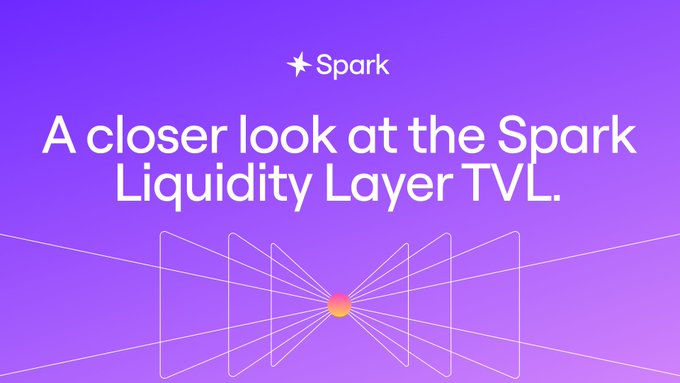Understanding Spark's TVL and Capital Allocation Strategy
Understanding Spark's TVL and Capital Allocation Strategy
🤔 TVL's Hidden Secret

Spark's Liquidity Layer (SLL) is redefining how TVL should be measured in DeFi. Unlike traditional protocols that simply lock capital, SLL actively allocates funds across multiple protocols and chains.
Key points:
- Currently allocating $2.38B in assets onchain
- Holds ~40% market share as an Onchain Capital Allocator
- Operates across Arbitrum, Base, and Ethereum
The traditional TVL metric appears split because SLL deploys capital externally. When enabling 'Double Counting', the full picture emerges, showing LP tokens and vault positions across the ecosystem.
This approach maximizes capital efficiency by:
- Ensuring deeper liquidity
- Generating competitive yields
- Reducing idle capital
The Spark TVL needs a closer look. Spark is growing, with an expanding supply and multiple new capital integrations between TradFi, CeFi, and Defi. But what about the Spark Liquidity Layer's TVL? Let's have a look 👇
Spark is now the largest Onchain Capital Allocator in the world. Spark is currently allocating $2.38 billion in assets onchain, making it the leader in this newly defined category with ~40% market share contribution. See it for yourself 👇 defillama.com/protocols/Onch…
Moving capital for deeper liquidity & better DeFi Spark is the Onchain Capital Allocator that programmatically deploys $2.3B+ in liquidity across DeFi for maximum capital efficiency and less liquidity fragmentation. Upgrading your borrowing & lending experience. Here’s how ⤵️
Spark is now listed as an Onchain Capital Allocator on @DefiLlama! But that's not even the best part. Spark has defined this new category - Onchain Capital Allocator for DeFi. Check it out 👇 defillama.com/protocols/onch…
Now tracking @sparkdotfi Liquidity Layer on @ethereum , @arbitrum & @base The Spark Liquidity Layer (SLL) automates liquidity provision of USDS, sUSDS, and USDC directly from Sky across various blockchain networks and DeFi protocols
In DeFi, liquidity isn’t enough. That’s why Spark doesn’t just provide liquidity, but also orchestrates it as the onchain capital allocator of DeFi. Spark allocates capital where it's needed most to ensure competitive yields and higher capital efficiency for all. Dive in 👇
A bank wouldn't tell you this, so Spark will. Banks optimize for profits, Spark optimizes for more competitive yields on your Savings. Allocating your saved capital across DeFi to get you higher capital efficiency and better APYs. Here's what it means 👇
🔵 Spark's Blue-Chip Strategy

**Spark Protocol** focuses on blue-chip collateral as its foundation for institutional-grade DeFi lending. **Key Requirements:** - High market cap and liquidity for large transactions - Low volatility to minimize protocol risk - Proven track record across market cycles **Primary Assets:** - **Stablecoins**: USDS, USDT, USDC meet all criteria - **Major cryptos**: ETH and BTC qualify through deep liquidity This approach enables **higher LTV ratios** and maximizes capital efficiency for users. Spark's strict risk management policies optimize liquidation thresholds and interest rates for each asset. The blue-chip focus creates a stable environment where institutional investors can deploy capital confidently, positioning Spark as an institutional-grade protocol in the DeFi space.
Spark Protocol Reaches $8.5B TVL, Ranks 5th Among DeFi Protocols

**Spark Protocol has achieved $8.5B in total value locked (TVL)**, ranking 5th among all DeFi protocols. The protocol positions itself as institutional-grade DeFi through several key features: **Architecture designed for institutions:** - Built specifically for institutional investors and experienced DeFi users - Supports stable, diverse bluechip collateral for portfolio flexibility - Implements validated risk parameters and liquidity monitoring systems - Prioritizes capital protection **Transparency and stability:** - First SubDAO in the Sky Ecosystem - Connected to Sky, which issues the world's 3rd largest stablecoin - Both USDS supply and Spark's TVL have grown monthly since launch - All fund movements are visible and verifiable on-chain **Deep liquidity for large transactions:** - $8.5B TVL provides essential depth for institutional investors - Enables execution of large transactions without significant slippage - Access to Sky Ecosystem's stablecoin liquidity when needed The protocol emphasizes that its institutional-grade status comes from its structure and operating model, not just TVL size.
⚡ Spark Savings V2 Breaks $300M

**Spark Savings V2 has crossed $300M in total value locked**, marking continued growth in demand for the institutional-grade savings protocol. **Key capacity increases:** - USDT cap raised to 500M - USDC cap raised to 500M - ETH cap raised to 100K ETH The protocol offers **non-custodial access to real-time compounding growth** with no platform fees or slippage. Users can deposit stablecoins or ETH and withdraw anytime in the same asset. This milestone comes as Spark leads the onchain capital allocator market with over $3B in TVL across all chains, up from $111M just 18 months ago.
🗳️ Spark Opens Voting on Major Buyback Proposal
**Spark launches critical governance vote** on implementing a buyback mechanism through the SubDAO Proxy Management Plan. **Key Details:** - Spark has accumulated **over $10 million** in treasury since June launch - Excess funds beyond risk capital and operational expenses will be used for **SPK token purchases** - Buyback size **increases programmatically** as treasury grows - Mechanism designed to align protocol operations with **long-term sustainability** **Why It Matters:** This proposal creates a transparent framework connecting treasury management, protocol operations, and community incentives. The automated system ensures responsible capital allocation while supporting token value. **Vote now** on this foundational upgrade for Spark's future growth.
🗳️ Spark Governance Polls Open

**New governance polls are now live** for Spark protocol community members. **Key Details:** - Voting deadline: November 27th, 2025 - Eligible voters: SPK and stSPK token holders - Platform: Snapshot governance portal **How to Participate:** - Visit the [governance portal](https://snapshot.box/#/s:sparkfi.eth/proposals) - Connect your wallet - Cast your vote on active proposals This follows Spark's regular weekly governance cycle, giving community members ongoing input into protocol decisions and development direction. *Your vote matters - participate in shaping Spark's future.*






